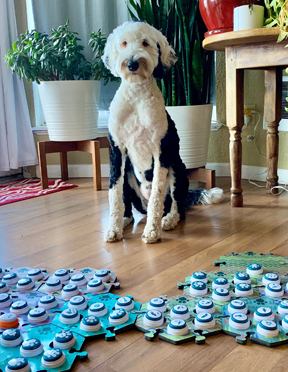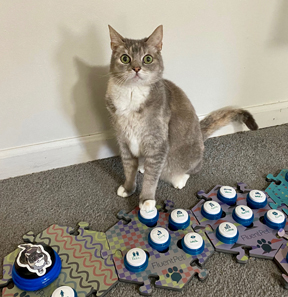Bunny

Photo by Alexis Devine
Bunny the sheepadoodle became a TikTok sensation through videos that show her "talking" by pressing buttons that sound words.
 Listen to this story.
Listen to this story.
Imagine that a pet dog has undiagnosed cancer on her lower rib cage. In pain, the dog might become withdrawn or aggressive, but instead, she walks over to a sounding board placed on the floor by her owner. With her paw, the dog presses four buttons, sounding the words "tummy," "ouch," "help" and "now." The owner immediately books a veterinary exam, asking the doctor to check the dog's abdomen.
Such a scenario may seem fanciful, based on the reasonable assumption that dogs lack the cognitive ability to communicate in human language, especially by combining words to concoct novel sentences. But a pioneering study led by scientists at the University of California, San Diego, could challenge that assumption, with potentially profound implications for animal welfare and the practice of veterinary medicine.
The project, named TheyCanTalk, involves about 2,500 dogs and 160 cats, each with access to a paw-activated sounding board. Owners and scientists are studying the subjects in their own homes, situated in 40 countries, including the United States, Canada, United Kingdom, Brazil and Japan, using multiple languages.
TheyCanTalk was inspired in part by its most famous research subject: Bunny, a sheepadoodle sensation on the social media platform TikTok.
Bunny achieved celebrity status last year after her owner, Alexis Devine, started placing buttons on the floor of their living room in Tacoma, Washington. The TikTok page is frequently updated with videos of Bunny "talking," now from 83 buttons, and has about six million followers.
Devine was inspired to train Bunny by Christina Hunger, a San Diego-based speech pathologist who similarly taught her dog, Stella, to use buttons to communicate dozens of words.
Training entails owners frequently pushing buttons to convey and reinforce the words for objects, behaviors or concepts. Buttons for words such as "outside" are relatively simple to teach: An owner pushes the "outside" button every time their pet goes outside. For more abstract concepts, such as "ouch" or "now," trainers act out scenarios or teach them in context with simpler words, such as "walk." (Devine explains her teaching method for Bunny on a YouTube channel, and gives tips for reinforcing expressions such as "help" and "love you.")
Federico Rossano, director of UC San Diego's Comparative Cognition Lab, stresses TheyCanTalk isn't about training dogs to learn words. That's obviously achievable, he said, citing the case of a border collie named Rico who could recognize more than 200 terms.
"What we want to know for real is, once they learn the different concepts and signals, what do they do with it?" Rossano, a cognitive scientist, told the VIN News Service. "Do they produce multi-signal combinations, kind of like a toddler would speak a two-word sentence? And then, what about a three-word sentence? What kind of things do they talk about?"
Dogs and cats are a new frontier
Studies of animals' ability to communicate with humans, including how they feel, are nothing new. Great apes, parrots and dolphins long have been the subject of intensive research, according to an overview by animal psychologist Irene Pepperberg, who famously worked for decades with Alex, an African gray parrot. Other notable subjects in the field include Washoe, a chimpanzee; Koko, a gorilla; and, more recently, Kanzi, a bonobo, who at age 40 can communicate more than 500 words via a lexigram keyboard.
The earlier studies had notable limitations, Rossano maintains. They typically involved only one research subject, and progress often wasn't systematically documented. For those and various other reasons, the true extent of nonhuman animals' ability to communicate using human language — or at least something vaguely akin to it — remains a contentious question in scientific circles.
With previous experimental design flaws in mind, TheyCanTalk has cast a wide net to encompass thousands of dog and cat subjects of various ages and breeds. The first phase, underway, involves owners monitoring pets and responding to questionnaires, holding video calls with scientists or sending them clips. The second phase, now being piloted, will see cameras installed in pets' homes to monitor them around the clock. In the third and final phase, select candidates will take part in behavioral experiments.
Rossano said the team aims this summer to submit its first scientific paper, and wants this fall to enter phase three, from which it hopes to have more to report in the 2021-22 academic year.
Another unique element of the research he highlights is that unlike studies involving great apes or exotic birds, the subjects haven't been removed from their natural environments. Dogs and cats have lived closely with humans for millennia, he said, and have a much better understanding of human communicative signals than nonhuman primates.
Billi the cat

Photo by Kendra Baker
Billi, one of about 160 pet cats being studied for their ability to communicate using a sounding board, is up to 36 buttons. Some of her more frequently used buttons are "play," "pets," "outside," "worm" (indicating a toy) and "mad."
So far, certain individuals have shown particular promise, including some cats, which are notoriously hard to train. One feline, called Billi, now knows 36 words, Rossano said.
In Bunny's case, many of her apparent communications are unsurprising ("hi," "come," "play"); some are cute ("more," "scritches," "now"); and some suggest that she may have a cursory awareness of the concept of time ("soon" in combination with "park").
Of more direct relevance to the veterinary community, Bunny has indicated when she is in pain. Once, Devine took Bunny to a veterinarian after she pushed the question mark ("?") button and "ouch." The sheepadoodle was found to have a cut on her nose. On another occasion, Bunny sounded "mad," "ouch," "stranger" and "paw," leading Devine to discover a foxtail in the dog's foot.
Some owners with multiple participating dogs have reported instances of a dog using the sounding board to communicate on behalf of its canine housemates, Rossano said. Owners also have reported less indoor barking since the sounding board arrived, suggesting their dogs are less vocal, and perhaps less frustrated, because they have a more effective means of communicating their feelings and desires.
Still, whether dogs such as Bunny are intentionally combining words or randomly pushing buttons to get their owners' attention remains to be determined. Scientists including Rossano are all too aware of the powerful influence of the Clever Hans effect — an expression used to describe the unintentional cueing of a desired behavior in subjects by their questioner. Clever Hans was a horse in Germany who could apparently answer math questions posed by his trainer by tapping his foot. It turned out that Hans was no math prodigy: He read subtle clues from his owner, such as facial expressions and changes in body posture, to figure out when to stop tapping.
Veterinarians' thoughts about Bunny
Dr. Daniel Mills, a veterinary behavior specialist at the University of Lincoln in England, views sounding-board cases such as Bunny's with a degree of skepticism. "Certainly from some of the videos I have seen, there is a lot of owner cueing and seeing what they want to see," Mills said. But he added: "That does not mean a dog could not learn certain associations to help in communication."
Dogs and cats already show an array of signals that communicate pain to humans. Dr. Christine Calder, a veterinary behaviorist in Portland, Maine, said limping, or licking and biting sore body parts, are among the most obvious. Subtler signs include loss of appetite, hiding more or sleeping more.
Some animals even show aggression to their owners when they're hurting, such as in a recent case that Calder recalled of an older dog who eventually was found to have cancer on her rib cage. Consequently, Calder suspects sounding boards could improve human awareness of certain types of animal suffering, even if the animal can manage to press only a couple of buttons.
"We don't speak the same language as they do," Calder said. "They're very much into body language, and we're very much into words. So having something that could bridge that communication gap would be excellent."
Other practitioners question whether many owners would find time to train their pet — an often long and tedious undertaking. "It's just not always practical to have owners teaching their dogs this stuff," said Dr. Ronnie Schenkein, a retired veterinarian in Coudersport, Pennsylvania. "What is practical is to train the veterinarians to respect the complexity of the animal's thoughts — and I would submit that an awful lot of veterinarians already have that mindset. But some more than others."
Schenkein long has had an interest in animal communication, having given a talk on the subject in 2016 at Oxford University, and says she's had pets, including a parrot, that showed an almost uncanny knack for understanding her feelings. She personally has little doubt that nonhuman animals can create novel sentences. But she would like to see humans spend more time understanding animals' ways of communicating rather than the other way around. "I know as a tourist that the French people are going to treat you a whole lot better if you try to speak French, even a little," she said.
Rossano respects Schenkein's point but reckons humans will more readily embrace the opportunity to teach pets something similar to human language. "People are more willing to play with gadgets and just do things that make it easier for them," he said.
Among Rossano's collaborators on TheyCanTalk is Leo Trottier, a cognitive scientist who developed the sounding board used by Bunny. The product, marketed by the company FluentPet, has been sold to more than 25,000 pet owners since its inception in 2019. (Participants in TheyCanTalk can use other sounding boards if they like.)
"Not every dog is going to be like Bunny," Rossano said. "But I'd imagine a lot of owners might want to spend some time on training because they love their pet, want to improve their relationship with them and will be proud of what they can achieve."
And while it remains to be seen whether pets really can construct sentences, Rossano, like Calder, says getting them to learn even a few words could alert owners to their suffering. "With proper training and with attentive owners, I think many dogs can get to at least 15 to 20 buttons," Rossano said. "And if you can train them to use the right button, based on the body part that is hurting, that in and of itself would be huge."